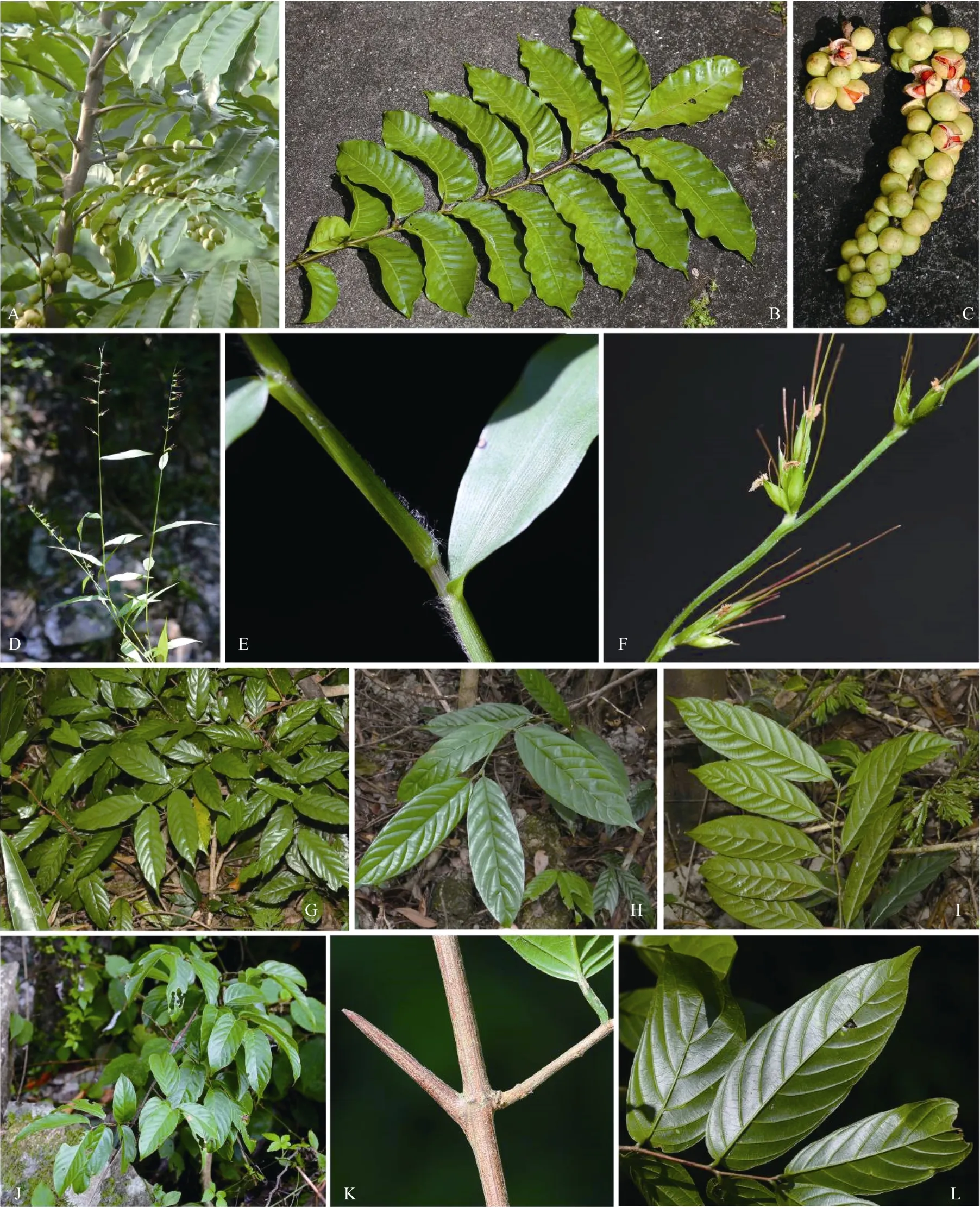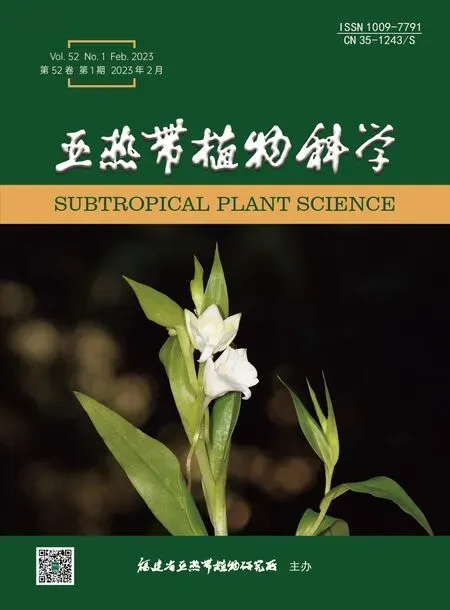中国香港植物新记录
朱慧玲,刘金刚,黄筑君,Craig WILLIAMS,幸敬阳,张金龙*,Stephan W.GALE
(1.嘉道理农场暨植物园植物保育部,中国 香港;2.深圳市兰科植物保护研究中心, 广东 深圳 518000)
Hong Kong lies on the southeastern coast of China and experiences a subtropical monsoon climate[1].2175 native vascular plant species are recorded in the latestCheck List of Hong Kong Plants[2].However, despite its tiny land area (1100 km2) and long history of extensive botanical exploration, new species continue to be described from the territory—for example,Gastrochilus kadoorieiKumar, S.W.Gale, Kocyan, G.A.Fisch.& Aver.[3],Carpinus insularisN.H.Xia, K.S.Pang & Y.H.Tong[4],Thismia hongkongensisS.S.Mar & R.M.K.Saunders[5]—and more than 40 vascular plant species new to Hong Kong have been reported in the past ten years alone[6—14].
In this article, six newly recorded native vascular plant species and two naturalised species are documented for the flora of Hong Kong, of which two represent new generic records.Voucher specimens have been deposited in the herbarium at Kadoorie Farm and Botanic Garden (KFBG).
1 Native species
1.1 Aphanamixis polystachya (Wall.) R.Parker 山楝 (Meliaceae) (Fig.1 A-C)

Fig.1 Four native species of seed plants recorded newly in Hong Kong
Indian Forester 57: 486.1931; Fl.Reipubl.Popularis Sin.43 (3): 79, pl.19: 1-10.1997; Fl.China 11: 125.2008.——Aglaia polystachyaWall.in Fl.Ind.[Roxburgh] 429.1824; Pellegr.in Lecomte, Fl.Indo-Chine 1: 768.1911.——Andersonia rohitukaRoxb., Hort.Bengal.87.1814.——Amoora rohituka(Roxb.) Wight & Arn., Prodr.Fl.Ind.Orient.1: 119.1834.——Aphanamixis rohituka(Roxb.) Pierre, Fl.Forest.Cochinch.5 (22) t.344b.(1896).——Chuniodendron yunnanenseHu in J.Roy.Hort.Soc.63: 387.1938.
Specimens examined: CHINA.Hong Kong: New Territories, Tai Po, Yuen Tun Ha, alt.100 m, 21 October 2020,Chuk-kwan Wong,MW0320(KFBG, barcode: KFBG016546).
Habitat: Mixed evergreen broad-leaved and deciduous forests on mountain slopes.
Phenology: Flowering in May-September, fruiting in October-April.
Distribution: Bhutan, India, Indonesia, Laos, Malaysia, Papua New Guinea, Philippines, Sri Lanka, Thailand, Vietnam; Pacific islands (Solomon Islands); China (Fujian, Guangdong, Guangxi, Hainan, Yunnan, Hong Kong, Taiwan (Lan Yu)).
Notes: Polygamo-dioecious shrub or tree up to 30 m tall.Leaves odd-pinnate; leaflets (5-)9-21, basal pair smallest, opposite or subopposite; base of leaflets frequently oblique, with transparent tiny spots visible in sunlight.Male flowers borne in panicles, female or bisexual flowers borne in racemes.Capsule spherical- pyriform to nearly ovoid.
The genusAphanamixisBlume is here recorded in Hong Kong for the first time.Four species in this genus were included inFlora Reipublicae Popularis Sinicae(FRPS)[15], but the other three (A.grandifoliaBl.,A.sinensisHow et T.Chen,A.tripetala(Blanco) Merr.) were all merged intoA.polystachyainFlora of China(FOC)[16].
1.2 Oplismenus undulatifolius (Ard.) Roemer & Schuit.求米草 (Poaceae) (Fig.1 D-F)
Ess.Agrostogr.54.171, 1812; Roem.et Schuit.Syst.Veg.2: 482.1817; Fl.Reipubl.Popularis Sin.10 (1): 242, pl.74: 6-9.1990; Fl.China 22: 501.2006.——Panicum undulatifoliumArd., Animadv.Bot.Spec.Alt.14 (t.4) 1764.——Orthopogon undulatifolius(Ard.) Spreng., Syst.Veg.1: 306.1824.
Specimens examined: CHINA.Hong Kong: New Territories, Tai Mo Shan, Sai Nam Stream, alt.533 m, 10 October 2020,Jin-gang Liu,JG0976(KFBG, barcode: KFBG016526); New Territories, Tai Mo Shan, Mo Tung Lam Path, alt.730 m, 16 October 2020,Jin-gang Liu,JG0987(KFBG, barcode: KFBG016527); New Territories, Tai Mo Shan, Tai Shek Stream, KFBG, alt.605 m, 24 October 2017,Jin-gang Liu & King-yeungHang,KFBGPS-0029(KFBG, barcode: KFBG013936).
Habitat: Light shade in moist places in broad-leaved forests.
Phenology: Flowering and fruiting in July-November.
Distribution: Warm-temperate and subtropical regions of the northern hemisphere, as well as upland parts of India and Africa.China (Anhui, Fujian, Guangdong, Guangxi, Yunnan, Guizhou, Sichuan, Hubei, Hunan, Jiangsu, Zhejiang, Jiangxi, Hebei, Henan, Shandong, Shaanxi, Shanxi, Taiwan, Hong Kong).
Notes: Perennial herb.The stem base lies on the ground and roots at the nodes.This species is readily distinguished fromOplismenus compositus(L.) P.Beauv.on account of its: a) short inflorescence branches; b) hispidulous leaves and inflorescence axis, or densely tuberculate-hairy leaf sheaths and leaf blades; and c) clustered or paired spikelets.
1.3 Sageretia ellipsoidea Yi Yang, H.Sun & H.Peng 椭果雀梅藤 (Rhamnaceae) (Fig.1 G-I)
PhytoKeys 179: 20, figs.5-7, 2021.
Specimens examined: CHINA.Hong Kong: New Territories, Lantau Island, Lantau Peak, Fung Pik Stream, alt.646 m, 30 December 2020,Jin-gang Liu,JG1171(KFBG, barcode: KFBG016745); New Territories, Lantau Island, Lantau Peak, Nam Tin Mun Stream, alt.222 m, 3 May 2020,Jin-gang Liu,JG0873(KFBG, barcode: KFBG016421); New Territories, Lantau Peak, Nam Tin Mun Stream, alt.293 m, 21 January 2018, fr,King-yeung Hang,HKY0210(KFBG, barcode: KFBG015534); New Territories, Lantau Island, Lantau Peak, alt.796 m, 16 June 2018,Cheuk-heiHon,HH0506(KFBG, barcode: KFBG016070); New Territories, Lantau Island, Ngong Ping 360 Rescue Trail, alt.510 m, 13 October 2016,Jin-longZhang,JL0756(KFBG, barcode: KFBG009348, KFBG009349); New Territories, Lantau Island, Wong Lung Hang, 26 October 1996,Fu-wu Xing,8247(KFBG, barcode: KFBG008230); New Territories, Lantau Island, Wong Lung Hang Country Trail, alt.615.7 m, 10 January 2017,Jin-long Zhang,JL1111(KFBG, barcode: KFBG009535); New Territories, Pat Sin Leng, Wang Chung Stream, the left branch (Bamboo Stream), alt.228 m, 14 March 2020, fl,Jin-gangLiu,JG0825(KFBG, barcode: KFBG016244); New Territories, Ma On Shan, Mau Ping, 28 June 1996,Fu-wu Xing,7232(KFBG, barcode: KFBG008228); New Territories, Ma On Shan, Mau Ping, alt.250 m, 29 November 2014,Jin-long Zhang,JL0204(KFBG, barcode: KFBG002317, KFBG002315); New Territories, Tai Po, Pat Sin Leng Nature Trail, alt.257 m, 6 December 2016,Jin-long Zhang,JL0981(KFBG, barcode: KFBG009533, KFBG009534); New Territories, Tai Po, Tai Mo Shan, 19 September 2014,Jin-long Zhang,JL0128(KFBG, barcode: KFBG002316).
Habitat: Shaded streamside in broadleaved forests.
Phenology: Flowering in March, fruiting in January.
Distribution: Fujian, Guangdong, Guangxi, Hainan, Hong Kong, China.Probably in northern Vietnam.
Notes: This species was previously reported asSageretia lucidaMerr.in Hong Kong[17].However, according to Yang et al.[18],S.lucidais endemic to Yingde in Guangdong Province, and grows on limestone mountains.More recently, Law[19]pointed out that the species occurring naturally in Hong Kong should beS.ellipsoideaYi Yang, H.Sun & H.Peng, a view shared by Yang Yi (pers.comm.), one of the authors of the name, himself.Although numerous specimens of this taxon have been collected from a number of locations throughout Hong Kong, all were collected beside rocky streams.Surprisingly, however, it was not included in eitherFlora of Hong Kong[20]or theCheck List of Hong Kong Plants[2].
S.ellipsoideais very similar toS.hamosa(Wall.) Brongn., but the former is distinguished from the latter on account of a) its generally smaller leaf blades (5-12 × 2.5-4 cm as opposed to 8-15(-25) × 3.5-7 cm inS.hamosa); b) the presence of 5-7 pairs of lateral veins on the leaves(as compared to 7-11 pairs inS.hamosa); c) a generally shorter floral rachis (1-3(-10) cm long as compared to 6-20(-25) cm inS.hamosa); and d) ellipsoidal to elliptic-ovoid fruits inS.ellipsoidea, as opposed to subglobose to globose fruits inS.hamosa.
1.4 Sageretia hamosa (Wall.) Brongn.钩刺雀梅藤 (Rhamnaceae) (Fig.1 J-L)
Mém.Fam.Rhamn.53.1826; Fl.Reipubl.Popularis Sin.48 (1): 14, pl.3: 1-2, 1982; Fl.China 12: 138.2007.——Zizyyhus hamosaWall.in Roxb., Fl.Ind.[Roxburgh] 2: 369.1824.
Specimens examined: CHINA.Hong Kong: New Territories, Tai Mo Shan, Tai Lui Stream (Tai Mo Shan to Lui Kung Tin), alt.602 m, 17 October 2019,King-yeungHang,HKY0445(KFBG, barcode: KFBG016112); New Territories, Tai Mo Shan, Tai Lui Stream, alt.629 m, 25 October 2020,Jin-gang Liu,JG1015(KFBG, barcode: KFBG016652).
Habitat: Climbing on trees and rocks in dense broad-leaved forest and thickets on slopes.
Phenology: Flowering in July-August, fruiting in August-October.
Distribution: India, Indonesia, Nepal, Philippines, Sri Lanka, Vietnam.China (Fujian, Guangdong, Guangxi, Guizhou, Sichuan, SE Xizang (Zayu), Hubei, Hunan, Jiangxi, Zhejiang, Hong Kong).
Notes: Scandent shrub.See the notes provided forSageretiaellipsoideaand also[18].
1.5 Trachelospermum brevistylum Hand.-Mazz.短柱络石 (Apocynaceae) (Fig.2 A-C)

Fig.2 Four species of native and naturalised seed plants recorded newly in Hong Kong
Anz.Akad.Wiss.Wien, Math.-Naturwiss.Kl.58: 228.1921; Fl.Reipubl.Popularis Sin.63: 221, pl.77.1977; Fl.China 16: 167.1995; ——Trachelospermum suaveolensChun in Sunyatsenia 1: 298, fig.4.1934.——Trachelospermum cuneatumTsiang in Sunyatsenia 3: 149.1936.
Specimens examined: CHINA.Hong Kong: New Territories, Lantau Island, Lantau Peak, alt.773 m, 12 June 2020,Jin-gang Liu,JG0927(KFBG, barcode: KFBG016361); New Territories, Tai Mo Shan, alt.678 m, 10 October 2020,Jin-gang Liu,JG0983(KFBG, barcode: KFBG016800).
Habitat: Climbing on trees and rocks in open broad-leaved forest.
Phenology: Flowering in April-July, fruiting in August-December.
Distribution: China (Anhui, Fujian, Guangdong, Guangxi, Hunan, Guizhou, Sichuan, Xizang, Hong Kong).
Notes: Woody liana.Leaf blade narrowly elliptic and papery.Cymes terminal and axillary; follicles linear, divergent.
An apparent difference betweenTrachelospermum brevistylumandT.jasminoides(Lindl.) Lem.is the position at which the stamens are inserted relative to the dilated corolla tube: inT.brevistylumthe stamens are inserted at the base of the corolla tube, whereas inT.jasminoidesthey are inserted at the middle.In addition, the leaf blade ofT.brevistylumis thicker and narrower, and the veins are more obvious on the abaxial surface of the leaf.
1.6 Zingiber hainanense Y.S.Ye, L.Bai & N.H.Xia 海南姜 (Zingiberaceae) (Fig.2 D-F)
Phytotaxa 217: 75.2015.
Specimens examined: CHINA.Hong Kong: New Territories, Tai Mo Shan, Sai Nam Stream, 10 October 2020,Jin-gangLiu,JG0980(KFBG, barcode: KFBG016550, KFBG016551, KFBG016552); New Territories, Tai Mo Shan, the upper portion of Tai Shek Stream (Tai Mo Shan to Shek Kong), alt.681 m, fruiting, 28 November 2020,Jin-gang Liu,JG1093(KFBG, barcode: KFBG016561).
Habitat: In shade in broad-leaved forest understorey and moist places in valleys.
Phenology: This species was described in 2015 but its phenology was not stated.In Hong Kong, flowering from September to October and fruiting in November.
Distribution: China (Hainan, Hong Kong).
Notes: Perennial rhizomatous herb.Leaf sheaths longitudinally striate, white pubescent, lower sheaths purplish-red, upper ones green; ligule bilobed and puberulent.Bracts narrowly ovate, loosely arranged, labellum and lateral staminodes narrow and purplish, apex of labellum bifid.
Zingiber hainanenseresemblesZ.guangxienseD.Fang,but differs in the colours of its labellum and staminodes (purple red vs.yellowish-white throughout).It is also similar toZ.kawagoiiHayatain the shape of its rhizome, inflorescence structure and flower colour.However, it can be distinguished fromZ.kawagoiiby its linear or narrowly ovate labellum and lateral staminodes (vs.obovate-oblong inZ.kawagoii) and the bifid apex of its labellum (vs.emarginate apex inZ.kawagoii).
A population of about 50 individuals was discovered in Hong Kong.
2 Naturalised species
2.1 Alysicarpus ovalifolius (Schumach.) J.Léonard卵叶链荚豆 (Fabaceae) (Fig.2 G-I)
Bull.Jard.Bot.État Bruxelles 24: 88.1954; Fl.China 10: 290-292.2010.——Hedysarum ovalifoliumSchumach.Beskr.Guin.Pl.359.1827.
Specimens examined: CHINA.Hong Kong: New Territories, Tai Po, Nam Wa Po, alt.19 m, 7 October 2020,Jin-gangLiu,JG0966(KFBG, barcode: KFBG016538); New Territories, Lantau Island, Fan Lau, Shek Pik, alt.1 m, 16 September 2017,Jin-gang Liu,JG0494(KFBG, barcode: KFBG013773).
Habitat: Open grassy verges along roads and riverbanks, and coastal areas; sea level to 500 m.
Phenology: Flowering in September-October, fruiting in September-December.
Distribution: Native to tropical Africa, SW Asia and Madagascar.Introduced in China (Hong Kong, Taiwan), Australia, India and Japan (Ryukyu Islands).
Notes: Introduced herb.This species can be distinguished fromAlysicarpus vaginalis(L.) DC.by its smaller stature (10-60 cm in height vs.30-90 cm inA.vaginalis), dimorphic leaves (lower leaves orbicular to broadly oblong, upper ones lanceolate), puberulent stem, laxly flowered inflorescence and differently coloured flowers (purplish-blue or pinkish-purple corolla vs.red, reddish-purple, purplish-blue, or yellow).Its legumes bear dense minute hairs, mostly lack septa and have ridged joints.
2.2 Melothria pendula L.美洲马瓟儿 (Cucurbitaceae) (Fig.2 J-K)
Sp.Pl.1: 35.1753.Fl.China 19: 46-47.2011.
Specimens examined: CHINA.Hong Kong: New Territories, Nam Wa Po, 10 February 2017,Jin-gang Liu,JG0185(KFBG, barcode: KFBG009606).
Habitat: Ruderal weed in secondary forests and along ditches, roadsides and streams.
Phenology: Flowering and fruiting in January- December.
Distribution: Native to the Americas (S United States to Argentina).Introduced in SE Asia, China (Hong Kong, Taiwan).
Notes: Vine.Stems and petiole slender, hispid.Leaf blade hispid or scabrid-punctate, adaxially dark green, abaxially paler.Male flowers 3-12 in axillary fascicles, often with an accompanying solitary flower; female flowers solitary, often co-axillary with male flowers.Corolla yellow.Immature fruit mottled green, ripe fruit purplish-black.The herbarium specimenJG0185was collected from a roadside verge.The species was also observed on Lantau Island and Peng Chau Island.
The genusMelothriaL.is newly recorded in Hong Kong.
Acknowledgements:We thank Dr.Pankaj Kumar for help in preparing the figures and revisions to the citations, and Fung Ka-yan and Wong Sai-fong for processing the herbarium specimens.We also thank Dr.Bai Lin (South China Botanical Garden) for verification ofZingiber hainanense,Dr.Yang Yi (Jiangxi Agricultural University) for verification ofS.ellipsoideaandS.hamosa, and Dr.Tong Yi-hua (South China Botanical Garden) for valuable comments and suggestions.

